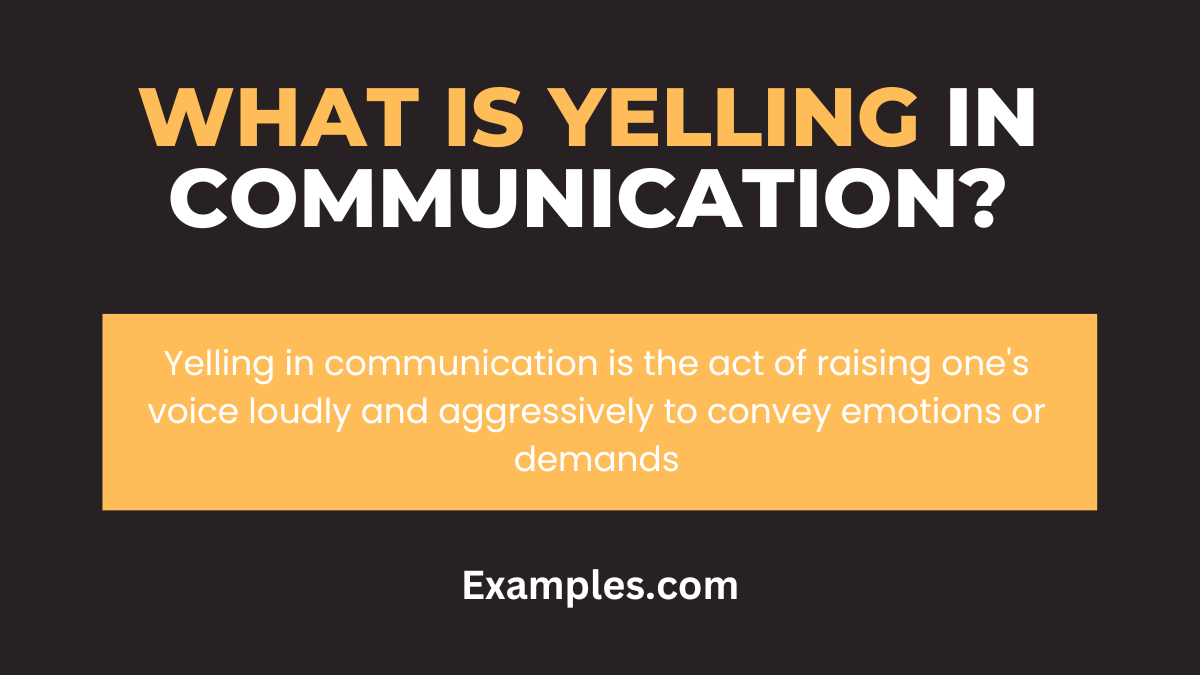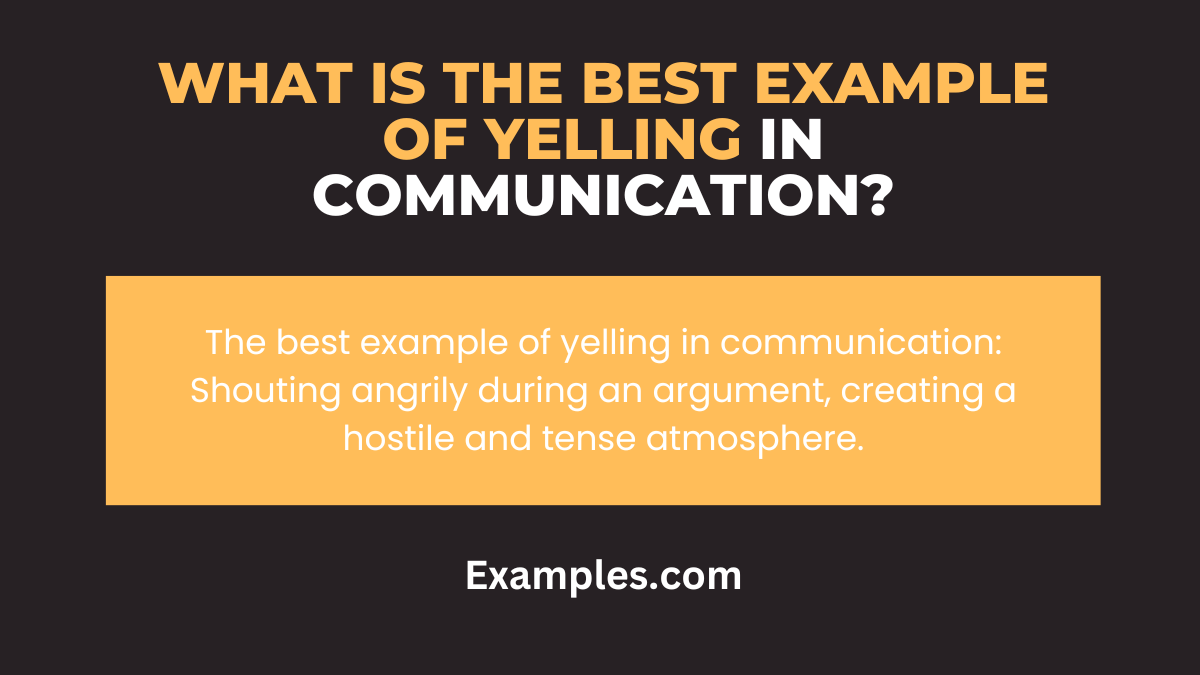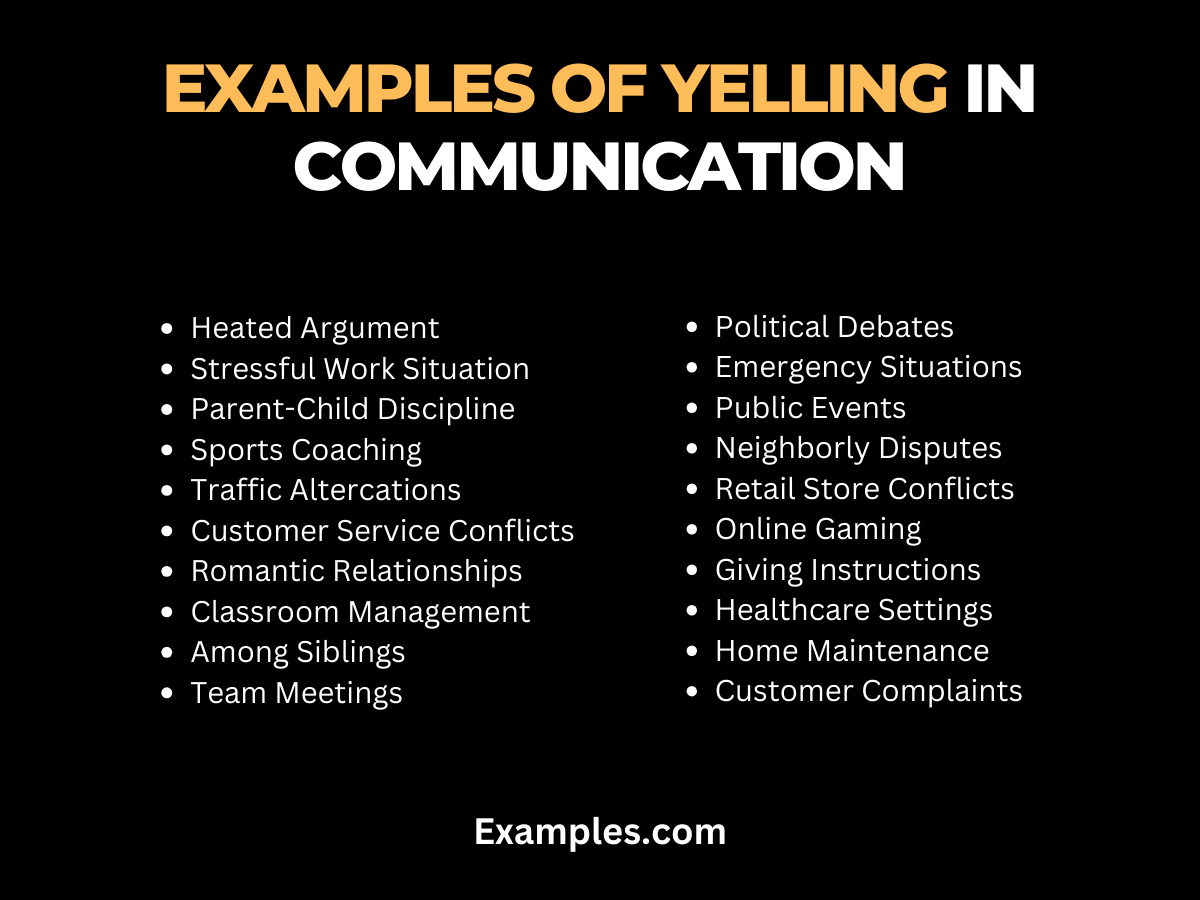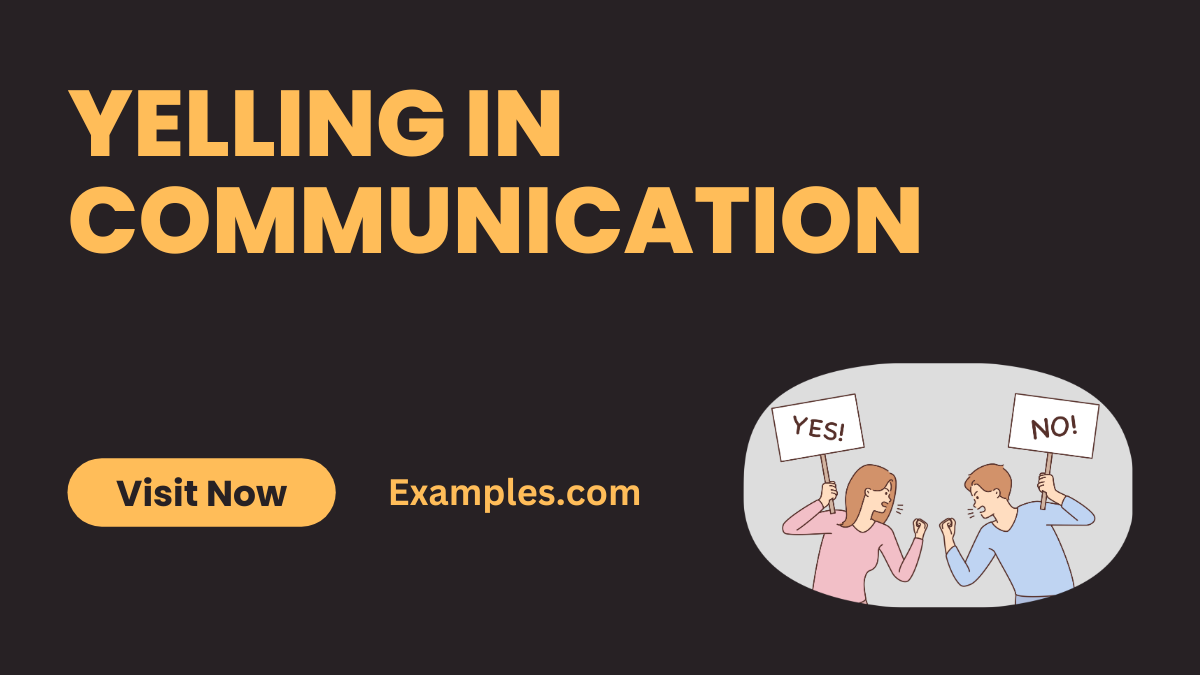19+ Yelling in Communication Examples
Yelling, a dynamic aspect of Interpersonal Communication, often surfaces in heated discussions or emotional exchanges. Understanding “Yelling in Communication” is crucial for managing its impact. This guide delves into its nuances, offering insights on using yelling effectively while maintaining respect and empathy in conversations. Learn to navigate this expressive yet challenging form of communication.
What is Yelling in Communication?

Yelling in communication refers to raising one’s voice significantly during conversations. It’s a form of verbal expression often loaded with emotion, whether anger, frustration, or passion. This communicative style can be both impactful and detrimental, depending on the context and delivery.
What is the Best Example of Yelling in Communication?

A common example is raising your voice during an argument to emphasize a point or out of frustration. It’s seen in personal disputes, professional disagreements, or even in moments of excitement and joy.
20 Examples of Yelling in Communication

Yelling, a form of Aggressive Communication, often undermines effective dialogue and can lead to conflict escalation. This article delves into 20 instances of yelling within various communication contexts, highlighting its impact and offering insights on alternative communication methods. Each example underlines the need for awareness and control over aggressive verbal expressions, such as yelling, in both personal and professional interactions.
- During a Heated Argument: Raising your voice to overpower the other person’s opinion. “I don’t care what you think, I am right!”
- In a Stressful Work Situation: Yelling at a colleague due to stress or frustration. “Why can’t you ever do this right?”
- Parent-Child Discipline: Parents yelling at children to enforce discipline. “How many times do I have to tell you not to do that?”
- Sports Coaching: Coaches yelling at players to motivate or correct them. “You need to focus and play better!”

- During Traffic Altercations: Engaging in yelling during road rage incidents. “Learn how to drive properly!”
- In Customer Service Conflicts: Customers yelling at service staff over dissatisfaction. “This is unacceptable service!”
- In Romantic Relationships: Partners raising their voices during arguments. “You never listen to me!”
- Classroom Management: Teachers yelling at students to maintain classroom order. “Everyone quiet down right now!”
- Among Siblings: Siblings yelling at each other during disputes. “Stop borrowing my things without asking!”
- In Team Meetings: Team leaders raising their voices to assert dominance. “This is my decision and that’s final!”
- During Political Debates: Politicians yelling to emphasize their points. “That policy is completely wrong!”
- In Emergency Situations: Yelling to alert others in case of danger. “Get out of the building now!”
- At Public Events: Yelling at someone who is obstructing your view. “Move out of the way, I can’t see!”
- In Neighborly Disputes: Raising your voice over boundary or noise issues. “Keep your noise down, I’m trying to sleep!”
- In Retail Store Conflicts: Shouting at store staff over a return or exchange issue. “I want to speak to your manager now!”
- Online Gaming: Yelling at other players during competitive games. “Why did you do that? You ruined the game!”

- When Giving Instructions: Raising your voice to be heard in a noisy environment. “Everyone, follow me this way!”
- In Healthcare Settings: Patients or their families yelling out of fear or frustration. “I need help here right now!”
- During Home Maintenance: Yelling at a contractor over dissatisfaction with their work. “This is not what I asked for!”
- In Customer Complaints: Raising your voice to express a complaint over the phone. “I demand to be compensated for this mistake!”
Effects of Yelling in Communication
- Increased Stress Levels: Yelling in communication often triggers stress and anxiety, both for the person yelling and the recipient.
- Damaged Relationships: Frequent yelling can erode trust and respect, damaging personal and professional relationships.
- Emotional Scarring: Repeated exposure to yelling can lead to long-term emotional trauma, especially in children.
- Miscommunication: Yelling can overshadow the message being conveyed, leading to misunderstandings.
- Physical Health Impact: Chronic yelling can contribute to health issues like high blood pressure and heart problems.
- Reduced Problem-Solving Efficiency: Yelling often escalates conflicts instead of resolving them.
- Impact on Self-Esteem: Being frequently yelled at can diminish a person’s self-esteem and confidence.
- Creates a Hostile Environment: Yelling contributes to a toxic, hostile environment, be it at home or in the workplace.
Causes of Yelling in Communication
- Emotional Overwhelm: Inability to handle intense emotions can lead to yelling.
- Lack of Communication Skills: Limited communication skills might lead someone to yell to express themselves.
- Stress and Frustration: High levels of stress or frustration can manifest as yelling.
- Desire for Control: Yelling is sometimes used as a tactic to dominate or control a situation or person.
- Modeling Behavior: Individuals who grew up around yelling may mimic this behavior.
- Feeling Unheard: Feeling that their words are not being listened to can lead to yelling as a means of being heard.
- Power Dynamics: In some cases, yelling is used to establish or maintain a power imbalance.
- Cultural Influences: Certain cultural backgrounds may normalize yelling in communication.
Types of Yelling in Communication
- Reactive Yelling: Impulsive yelling in response to immediate anger or frustration.
- Intentional Yelling: Deliberate yelling used as a control tactic or to assert dominance.
- Habitual Yelling: Regular yelling that becomes a default communication style.
- Situational Yelling: Yelling in specific circumstances, like high-pressure environments.
- Defensive Yelling: Yelling in response to feeling attacked or criticized.
- Manipulative Yelling: Yelling used to coerce or manipulate someone’s behavior.
- Frustration-Driven Yelling: Yelling stemming from inability to express frustration constructively.
- Fear-Induced Yelling: Yelling caused by fear or anxiety, often seen in emergency situations.
The impact of yelling in communication is vital. This guide has provided insights into recognizing aggressive behavior and its detrimental effects. By practicing effective communication strategies, such as active listening and empathy, we can promote respectful dialogue and healthier interactions. Avoiding yelling fosters understanding, enhances relationships, and contributes to more positive and constructive communication.
19+ Yelling in Communication Examples

Yelling, a dynamic aspect of Interpersonal Communication, often surfaces in heated discussions or emotional exchanges. Understanding “Yelling in Communication” is crucial for managing its impact. This guide delves into its nuances, offering insights on using yelling effectively while maintaining respect and empathy in conversations. Learn to navigate this expressive yet challenging form of communication.
What is Yelling in Communication?

Yelling in communication refers to raising one’s voice significantly during conversations. It’s a form of verbal expression often loaded with emotion, whether anger, frustration, or passion. This communicative style can be both impactful and detrimental, depending on the context and delivery.
What is the Best Example of Yelling in Communication?

A common example is raising your voice during an argument to emphasize a point or out of frustration. It’s seen in personal disputes, professional disagreements, or even in moments of excitement and joy.
20 Examples of Yelling in Communication

Yelling, a form of Aggressive Communication, often undermines effective dialogue and can lead to conflict escalation. This article delves into 20 instances of yelling within various communication contexts, highlighting its impact and offering insights on alternative communication methods. Each example underlines the need for awareness and control over aggressive verbal expressions, such as yelling, in both personal and professional interactions.
During a Heated Argument: Raising your voice to overpower the other person’s opinion. “I don’t care what you think, I am right!”
In a Stressful Work Situation: Yelling at a colleague due to stress or frustration. “Why can’t you ever do this right?”
Parent-Child Discipline: Parents yelling at children to enforce discipline. “How many times do I have to tell you not to do that?”
Sports Coaching: Coaches yelling at players to motivate or correct them. “You need to focus and play better!”

During Traffic Altercations: Engaging in yelling during road rage incidents. “Learn how to drive properly!”
In Customer Service Conflicts: Customers yelling at service staff over dissatisfaction. “This is unacceptable service!”
In Romantic Relationships: Partners raising their voices during arguments. “You never listen to me!”
Classroom Management: Teachers yelling at students to maintain classroom order. “Everyone quiet down right now!”
Among Siblings: Siblings yelling at each other during disputes. “Stop borrowing my things without asking!”
In Team Meetings: Team leaders raising their voices to assert dominance. “This is my decision and that’s final!”
During Political Debates: Politicians yelling to emphasize their points. “That policy is completely wrong!”
In Emergency Situations: Yelling to alert others in case of danger. “Get out of the building now!”
At Public Events: Yelling at someone who is obstructing your view. “Move out of the way, I can’t see!”
In Neighborly Disputes: Raising your voice over boundary or noise issues. “Keep your noise down, I’m trying to sleep!”
In Retail Store Conflicts: Shouting at store staff over a return or exchange issue. “I want to speak to your manager now!”
Online Gaming: Yelling at other players during competitive games. “Why did you do that? You ruined the game!”

When Giving Instructions: Raising your voice to be heard in a noisy environment. “Everyone, follow me this way!”
In Healthcare Settings: Patients or their families yelling out of fear or frustration. “I need help here right now!”
During Home Maintenance: Yelling at a contractor over dissatisfaction with their work. “This is not what I asked for!”
In Customer Complaints: Raising your voice to express a complaint over the phone. “I demand to be compensated for this mistake!”
Effects of Yelling in Communication
Increased Stress Levels: Yelling in communication often triggers stress and anxiety, both for the person yelling and the recipient.
Damaged Relationships: Frequent yelling can erode trust and respect, damaging personal and professional relationships.
Emotional Scarring: Repeated exposure to yelling can lead to long-term emotional trauma, especially in children.
Miscommunication: Yelling can overshadow the message being conveyed, leading to misunderstandings.
Physical Health Impact: Chronic yelling can contribute to health issues like high blood pressure and heart problems.
Reduced Problem-Solving Efficiency: Yelling often escalates conflicts instead of resolving them.
Impact on Self-Esteem: Being frequently yelled at can diminish a person’s self-esteem and confidence.
Creates a Hostile Environment: Yelling contributes to a toxic, hostile environment, be it at home or in the workplace.
Causes of Yelling in Communication
Emotional Overwhelm: Inability to handle intense emotions can lead to yelling.
Lack of Communication Skills: Limited communication skills might lead someone to yell to express themselves.
Stress and Frustration: High levels of stress or frustration can manifest as yelling.
Desire for Control: Yelling is sometimes used as a tactic to dominate or control a situation or person.
Modeling Behavior: Individuals who grew up around yelling may mimic this behavior.
Feeling Unheard: Feeling that their words are not being listened to can lead to yelling as a means of being heard.
Power Dynamics: In some cases, yelling is used to establish or maintain a power imbalance.
Cultural Influences: Certain cultural backgrounds may normalize yelling in communication.
Types of Yelling in Communication
Reactive Yelling: Impulsive yelling in response to immediate anger or frustration.
Intentional Yelling: Deliberate yelling used as a control tactic or to assert dominance.
Habitual Yelling: Regular yelling that becomes a default communication style.
Situational Yelling: Yelling in specific circumstances, like high-pressure environments.
Defensive Yelling: Yelling in response to feeling attacked or criticized.
Manipulative Yelling: Yelling used to coerce or manipulate someone’s behavior.
Frustration-Driven Yelling: Yelling stemming from inability to express frustration constructively.
Fear-Induced Yelling: Yelling caused by fear or anxiety, often seen in emergency situations.
The impact of yelling in communication is vital. This guide has provided insights into recognizing aggressive behavior and its detrimental effects. By practicing effective communication strategies, such as active listening and empathy, we can promote respectful dialogue and healthier interactions. Avoiding yelling fosters understanding, enhances relationships, and contributes to more positive and constructive communication.


